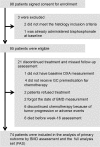A Prospective Observational Study on Effect of Short-Term Periodic Steroid Premedication on Bone Metabolism in Gastrointestinal Cancer (ESPRESSO-01)
- PMID: 28341762
- PMCID: PMC5423502
- DOI: 10.1634/theoncologist.2016-0308
A Prospective Observational Study on Effect of Short-Term Periodic Steroid Premedication on Bone Metabolism in Gastrointestinal Cancer (ESPRESSO-01)
Abstract
Background: A multicenter prospective observational study evaluated the effect of gastrointestinal cancer chemotherapy with short-term periodic steroid premedication on bone metabolism.
Patients and methods: Seventy-four patients undergoing chemotherapy for gastrointestinal cancer were studied. The primary endpoints were changes in bone mineral densities (BMDs) and metabolic bone turnover 16 weeks after initiation of chemotherapy. BMDs, measured by dual-energy x-ray absorptiometry, and serum cross-linked N-telopeptides of type I collagen (sNTX), and bone alkaline phosphatase (sBAP) were assessed for evaluation of bone resorption and formation, respectively.
Results: In 74.3% (55/74) of the patients, BMDs were significantly reduced at 16 weeks relative to baseline. The percent changes of BMD were -1.89% (95% confidence interval [CI], -2.67% to -1.11%: p < .0001) in the lumbar spine, -2.24% (95% CI, -3.59% to -0.89%: p = .002) in the total hip, and -2.05% (95% CI, -3.11% to -0.99%: p < .0001) in the femoral neck. Although there was no significant difference in sNTX levels during 16 weeks (p = .136), there was a significant increase in sBAP levels (p = .010). Decreased BMD was significantly linked to number of chemotherapy cycles (p = .02). There were no significant correlations between changes in BMDs and the primary site of malignancy, chemotherapy regimens, total cumulative steroid dose, steroid dose intensity, and additive steroid usage.
Conclusion: Gastrointestinal cancer chemotherapy with periodic glucocorticoid premedication was associated with reduced BMD and increased sBAP levels, which were linked to number of chemotherapy cycles but independent of primary site, chemotherapy regimen, duration, and additive steroid usage. The Oncologist 2017;22:592-600 IMPLICATIONS FOR PRACTICE: Bone health and the management of treatment-related bone loss are important for cancer care. The present study showed that a significant decrease in bone mineral density (BMD) and an increase in serum bone alkaline phosphatase levels occurred in gastrointestinal cancer patients receiving chemotherapy, which were linked to number of chemotherapy cycles but were independent of primary site, chemotherapy regimen, total steroid dose, and steroid dose intensity. Surprisingly, it seems that the decreasing BMD levels after only 16 weeks of chemotherapy for gastrointestinal cancer were comparable to that of 12-month adjuvant aromatase inhibitor therapy for early-stage breast cancer patients.
Keywords: bone alkaline phosphatase; bone mineral density; chemotherapy; gastrointestinal cancer; glucocorticoid premedication; steroid-induced osteoporosis.
© 2017 The Authors. The Oncologist published by Wiley Periodicals, Inc. on behalf of AlphaMed Press.
Conflict of interest statement
Disclosures of potential conflicts of interests may be found at the end of this article.
Figures



Similar articles
-
Effectiveness and safety of vitamin D in relation to bone health.Evid Rep Technol Assess (Full Rep). 2007 Aug;(158):1-235. Evid Rep Technol Assess (Full Rep). 2007. PMID: 18088161 Free PMC article.
-
Two-year follow-up study (PRIMROSE 3) to assess bone mineral density in subjects with uterine fibroids completing the PRIMROSE 1 and PRIMROSE 2 linzagolix trials.Hum Reprod Open. 2025 May 13;2025(3):hoaf025. doi: 10.1093/hropen/hoaf025. eCollection 2025. Hum Reprod Open. 2025. PMID: 40575397 Free PMC article.
-
Treatment for osteoporosis in people with beta-thalassaemia.Cochrane Database Syst Rev. 2023 May 9;5(5):CD010429. doi: 10.1002/14651858.CD010429.pub3. Cochrane Database Syst Rev. 2023. PMID: 37159055 Free PMC article.
-
Bisphosphonates for steroid-induced osteoporosis.Cochrane Database Syst Rev. 2016 Oct 5;10(10):CD001347. doi: 10.1002/14651858.CD001347.pub2. Cochrane Database Syst Rev. 2016. PMID: 27706804 Free PMC article.
-
Treatment for osteoporosis in people with ß-thalassaemia.Cochrane Database Syst Rev. 2016 Mar 10;3:CD010429. doi: 10.1002/14651858.CD010429.pub2. Cochrane Database Syst Rev. 2016. Update in: Cochrane Database Syst Rev. 2023 May 9;5:CD010429. doi: 10.1002/14651858.CD010429.pub3. PMID: 26964506 Updated.
Cited by
-
Impact of systemic dexamethasone dosage on docetaxel-induced oral mucositis in patients with breast cancer.Sci Rep. 2023 Jun 22;13(1):10169. doi: 10.1038/s41598-023-37285-9. Sci Rep. 2023. PMID: 37349388 Free PMC article.
-
Dexamethasone-Sparing Regimens with Oral Netupitant and Palonosetron for the Prevention of Emesis Caused by High-Dose Cisplatin: A Randomized Noninferiority Study.Oncologist. 2021 Oct;26(10):e1854-e1861. doi: 10.1002/onco.13851. Epub 2021 Jun 18. Oncologist. 2021. PMID: 34101934 Free PMC article. Clinical Trial.
-
Changes in bone metabolism after gastric cancer surgery in male patients: a prospective observational study.Gastric Cancer. 2019 Jan;22(1):237-243. doi: 10.1007/s10120-018-0835-9. Epub 2018 May 10. Gastric Cancer. 2019. PMID: 29748875
-
Taxane-Associated Acute Pain Syndrome: a Review of its Features and Management.Curr Treat Options Oncol. 2025 Mar;26(3):187-196. doi: 10.1007/s11864-025-01302-y. Epub 2025 Feb 28. Curr Treat Options Oncol. 2025. PMID: 40019675 Review.
-
Impact of dexamethasone-sparing regimens on delayed nausea caused by moderately or highly emetogenic chemotherapy: a meta-analysis of randomised evidence.BMC Cancer. 2019 Dec 30;19(1):1268. doi: 10.1186/s12885-019-6454-y. BMC Cancer. 2019. PMID: 31888544 Free PMC article.
References
-
- Roila F, Molassiotis A, Herrstedt J et al. 2016 MASCC and ESMO guideline update for the prevention of chemotherapy‐ and radiotherapy‐induced nausea and vomiting and of nausea and vomiting in advanced cancer patients. Ann Oncol 2016;27:v119–v133. - PubMed
-
- Lenz HJ. Management and preparedness for infusion and hypersensitivity reactions. The Oncologist 2007;12:601–609. - PubMed
-
- Peereboom DM, Donehower RC, Eisenhauer EA et al. Successful re‐treatment with taxol after major hypersensitivity reactions. J Clin Oncol 1993;11:885–890. - PubMed
-
- Bonomi P, Kim K, Fairclough D et al. Comparison of survival and quality of life in advanced non‐small‐cell lung cancer patients treated with two dose levels of paclitaxel combined with cisplatin versus etoposide with cisplatin: Results of an Eastern Cooperative Oncology Group trial. J Clin Oncol 2000;18:623–631. - PubMed
Publication types
MeSH terms
Substances
Associated data
LinkOut - more resources
Full Text Sources
Other Literature Sources
Medical

